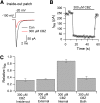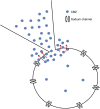Sidedness of carbamazepine accessibility to voltage-gated sodium channels
- PMID: 24319110
- PMCID: PMC3913360
- DOI: 10.1124/mol.113.090472
Sidedness of carbamazepine accessibility to voltage-gated sodium channels
Abstract
Voltage-gated sodium channels are inhibited by many local anesthetics, antiarrhythmics, and antiepileptic drugs. The local anesthetic lidocaine appears to be able to access its binding site in the sodium channel only from the membrane phase or from the internal face of the channel. In contrast, the antiepileptic drug carbamazepine was found to inhibit voltage-gated sodium channels only with external, but not internal, application, implying a major difference. We investigated this point using both whole-cell and inside-out patch recordings from human Na(v)1.7 channels in a stable cell line. In the whole-cell configuration, carbamazepine inhibited sodium current within seconds when applied externally, but had little or no effect when applied internally for up to 15 minutes, confirming previous results. However, carbamazepine inhibited sodium channels effectively and rapidly when applied to the internal face of the membrane using inside-out patch recording. We found that lidocaine also has little or no effect when applied intracellularly in whole-cell recording, but blocks effectively and rapidly when applied to the internal surface using inside-out patches. In contrast, the cationic lidocaine derivative QX-314 (N-ethyl-lidocaine) blocks effectively when applied internally with whole-cell dialysis, as well as when applied to inside-out patches. We conclude that carbamazepine and lidocaine access the sodium channel in similar ways and hypothesize that their lack of effect with internal dialysis in whole-cell recording reflects rapid exit through membrane near the pipette recording site. This effect likely limits the ability of any compound with significant membrane permeability to be applied intracellularly by whole-cell dialysis.
Figures





Similar articles
-
Low potency inhibition of NaV1.7 by externally applied QX-314 via a depolarizing shift in the voltage-dependence of activation.Eur J Pharmacol. 2022 Jun 15;925:175013. doi: 10.1016/j.ejphar.2022.175013. Epub 2022 May 7. Eur J Pharmacol. 2022. PMID: 35537491
-
Differential block of sensory neuronal voltage-gated sodium channels by lacosamide [(2R)-2-(acetylamino)-N-benzyl-3-methoxypropanamide], lidocaine, and carbamazepine.J Pharmacol Exp Ther. 2008 Jul;326(1):89-99. doi: 10.1124/jpet.107.133413. Epub 2008 Mar 31. J Pharmacol Exp Ther. 2008. PMID: 18378801
-
Development of a Rapid Throughput Assay for Identification of hNav1.7 Antagonist Using Unique Efficacious Sodium Channel Agonist, Antillatoxin.Mar Drugs. 2016 Feb 16;14(2):36. doi: 10.3390/md14020036. Mar Drugs. 2016. PMID: 26891306 Free PMC article.
-
[Lidocaine in oncological surgery: the role of blocking in voltage-gated sodium channels. A narrative review].Braz J Anesthesiol. 2020 Sep-Oct;70(5):527-533. doi: 10.1016/j.bjan.2020.04.018. Epub 2020 Sep 3. Braz J Anesthesiol. 2020. PMID: 32951865 Free PMC article. Review.
-
Blocking voltage-gated sodium channels as a strategy to suppress pathological cough.Pulm Pharmacol Ther. 2017 Dec;47:38-41. doi: 10.1016/j.pupt.2017.05.010. Epub 2017 May 15. Pulm Pharmacol Ther. 2017. PMID: 28522215 Review.
Cited by
-
Inhibition of NMDA receptors through a membrane-to-channel path.Nat Commun. 2022 Jul 15;13(1):4114. doi: 10.1038/s41467-022-31817-z. Nat Commun. 2022. PMID: 35840593 Free PMC article.
-
Trigeminal neuralgia: An overview from pathophysiology to pharmacological treatments.Mol Pain. 2020 Jan-Dec;16:1744806920901890. doi: 10.1177/1744806920901890. Mol Pain. 2020. PMID: 31908187 Free PMC article. Review.
-
Chimeric Glutamate Receptor Subunits Reveal the Transmembrane Domain Is Sufficient for NMDA Receptor Pore Properties but Some Positive Allosteric Modulators Require Additional Domains.J Neurosci. 2016 Aug 24;36(34):8815-25. doi: 10.1523/JNEUROSCI.0345-16.2016. J Neurosci. 2016. PMID: 27559165 Free PMC article.
-
Long-Term Blockade of Nociceptive Nav1.7 Channels Is Analgesic in Rat Models of Knee Arthritis.Biomolecules. 2022 Oct 26;12(11):1571. doi: 10.3390/biom12111571. Biomolecules. 2022. PMID: 36358921 Free PMC article.
-
Interaction of Varenicline with Classic Antiseizure Medications in the Mouse Maximal Electroshock-Induced Seizure Model.Int J Mol Sci. 2023 Jan 30;24(3):2616. doi: 10.3390/ijms24032616. Int J Mol Sci. 2023. PMID: 36768937 Free PMC article.
References
-
- Frazier DT, Narahashi T, Yamada M. (1970) The site of action and active form of local anesthetics. II. Experiments with quaternary compounds. J Pharmacol Exp Ther 171:45–51 - PubMed
-
- Khodorov B, Shishkova L, Peganov E, Revenko S. (1976) Inhibition of sodium currents in frog Ranvier node treated with local anesthetics. Role of slow inactivation. Biochim Biophys Acta 433:409–435
Publication types
MeSH terms
Substances
Grants and funding
LinkOut - more resources
Full Text Sources
Other Literature Sources

